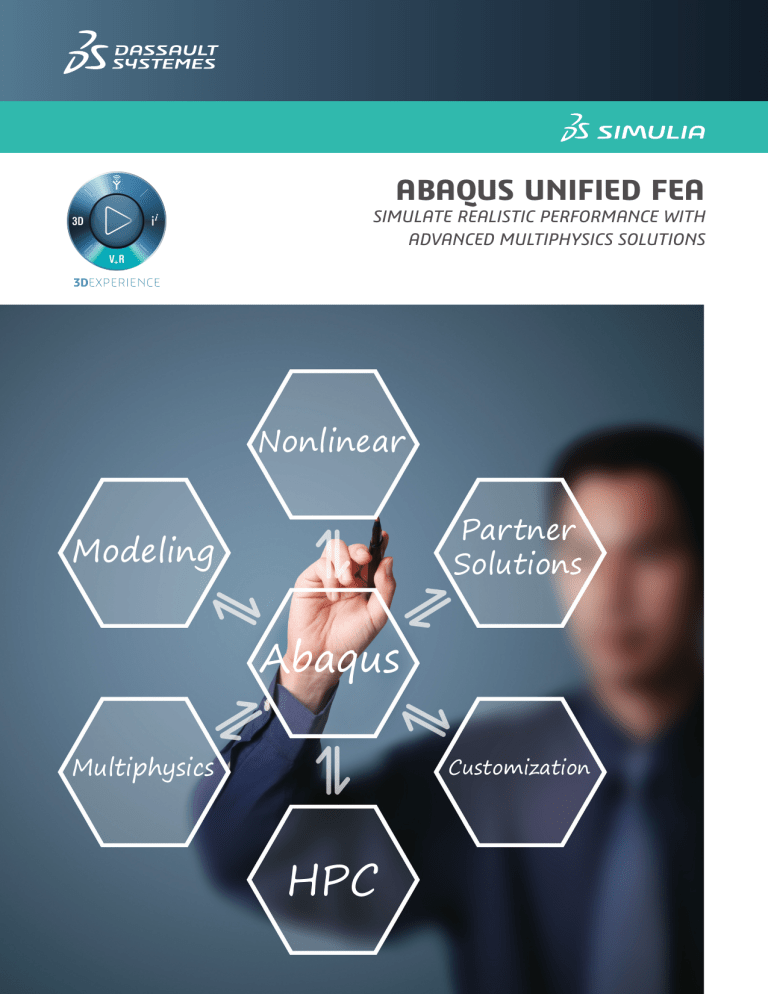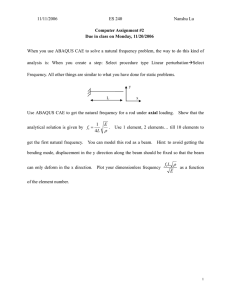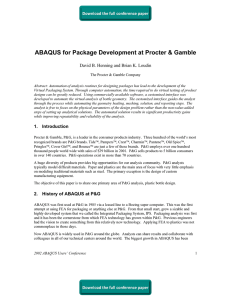
ABAQUS UNIFIED FEA SIMULATE REALISTIC PERFORMANCE WITH ADVANCED MULTIPHYSICS SOLUTIONS Nonlinear Partner Solutions Modeling Abaqus Multiphysics Customization HPC ABAQUS UNIFIED FEA Industry Challenges In the race to deliver new and innovative products to market faster, manufacturers face many challenges, including globalization, cost reductions, and shorter development cycles. To gain a competitive advantage in the marketplace, manufacturers have started to leverage the robust capabilities of realistic simulation to lessen dependency on physical testing, reduce part weight, or evaluate the use of alternative materials during the product design phase to ensure optimum product performance. Abaqus Unified FEA Solution SIMULIA delivers a scalable suite of unified analysis products that allow all users, regardless of their simulation expertise or domain focus, to collaborate and seamlessly share simulation data and approved methods without loss of information fidelity. The Abaqus Unified FEA product suite offers powerful and complete solutions for both routine and sophisticated engineering problems covering a vast spectrum of industrial applications. Best-in-class companies are taking advantage of Abaqus Unified FEA to consolidate their processes and tools, reduce costs and inefficiencies, and gain a competitive advantage. KEY BENEFITS FEA and Multiphysics • Linear and nonlinear • Coupled physics: structural acoustics, thermal-electrical, and more • Electromagnetics and smoothed particle hydrodynamics Complex Materials • Rubbers, thermo-plastics, powder metals, human tissue, soil, composites, and more Complex Assemblies • Flexible multibody dynamics, controls, and joint behavior Contact, Fracture & Failure • Crack, impact, and crash events High-Performance Computing • Scaling from 4 to 256 cores for rapid turnaround and large-scale analyses Model Preparation and Results Interpretation • Automation tools for customization of standard workflows Partners • Over 100 value-added solutions for Abaqus to address numerous industry processes Perform seamless parameter updating for design iterations with bidirectional associativity in Abaqus. Abaqus offers a sophisticated environment for accelerating contact modeling and mesh creation. Image courtesy of Ford Motor Company MODELING Abaqus offers a hybrid modeling approach that enables users to work with geometry-based data alongside imported meshes without associated geometry. It also provides a powerful modeling and visualization environment focused on complete support of Abaqus solver technology, customization capabilities, proven capture and reuse of analysis workflows, and the flexibility to implement user-defined subroutines. Feature-based, parametric modeling also makes Abaqus/CAE a highly efficient and effective pre- and postprocessor for every analysis need. Abaqus/CAE enables users to leverage the complete range of Abaqus analysis functionality, such as acoustics, connectors, damage, fracture, and failure. Familiar Abaqus concepts such as steps, interactions, sections, and materials make the user interface highly intuitive. Geometry Specialized Techniques Parts and assemblies can be created using the constraintdriven sketcher, or imported from CAD systems. In addition, CAD associative interfaces for CATIA V6, CATIA V5, SolidWorks, and Pro/ENGINEER allow the synchronization and rapid analysis iterations of CAD and CAE assemblies. The direct cyclic procedure provides a computationally efficient way to analyze steady-state response to cyclic loading, which is useful in applications where thermal fatigue is of concern, such as in electronics or powertrain. Meshing Abaqus/CAE offers a comprehensive meshing environment and provides a variety of sophisticated approaches for simplifying and speeding up mesh creation. Contact Abaqus provides comprehensive contact modeling capabilities, including the ability to model interactions between deformable bodies, rigid bodies, and self-contact. Abaqus automatically detects contact between different bodies, dramatically reducing missed contact definitions and time required to define contact in complex assemblies. Adaptive remeshing in Abaqus alleviates uncertainty in mesh creation by automatically remeshing only where necessary to ensure accuracy. The hydrostatic fluid cavity capability provides a simplified means to predict the mechanical response of structures, such as pressure vessels, hydraulically-driven mechanisms, or tires. Advanced Materials Increasing regulations, environmental concerns, and the need for lighter, more efficient products are forcing designers to seek out new materials such as lead-free solder, composites, and polymers. The Abaqus product suite provides an extensive library of material models that can be used to simulate the realistic behavior of biological tissue and traditional engineering materials, such as metals and rubber. ADVANCED ANALYSIS Linear & Nonlinear Multiphysics The implicit solution technology in Abaqus is ideal for solving static and low-speed dynamic events, such as sealing pressure in a gasket joint or crack propagation in a composite airplane fuselage. Many industrial applications today involve the interaction of multiple physical phenomena. For example, in order to design safe and effective drug-eluting stents, engineers must account for the interplay between blood flow and stent deformation. In addition to providing basic and advanced linear analysis capabilities, Abaqus also supports the general application of linear analysis techniques in cases where the linear response can depend on prior nonlinear load history, such as vibration of rotating machinery or the response of building structures due to earthquake loading. To address these applications, Abaqus provides robust multiphysics capabilities, including thermal-stress, thermalelectrical, low-frequency electromagnetics, structuralacoustics, and fluid flow through porous media. The explicit solution technology employed by Abaqus is well-suited for high-speed dynamic events, such as consumer electronics drop testing, automotive crashworthiness, and ballistic impact. The Computational Fluid Dynamics (CFD) capability in Abaqus provides technology for simulating incompressible fluid flow, including turbulence and deforming meshes, such as cooling of an automotive exhaust manifold or blood flow through an artery. Abaqus also supports coupling of independent and external CFD software to perform Fluid-Structure Interaction (FSI) analysis, including smoothed particle hydrodynamics and Coupled Eulerian-Lagrangian (CEL). Robustness and accuracy, combined with ease-of-use and high-performance computing, make Abaqus indispensible for simulating material and product behavior under real-world operating conditions. High-Performance Computing Visualization Reducing analysis turnaround time enables the examination of multiple and more detailed design scenarios. The distributed memory parallel direct solver technology in Abaqus sets a new benchmark for the industry, demonstrating impressive scaling and robustness. The parallel implementation of explicit dynamics in Abaqus, based on domain decomposition technology, greatly accelerates the solution process and boosts productivity. The comprehensive set of best-in-class visualization capabilities in Abaqus helps users interpret and communicate model data and analysis results. Visual diagnostics enable the progress of analyses to be tracked and assessed easily. Very large, complex models can be visualized using a wide range of options, including contour, path, X–Y, and ply stack plots. In addition, results in specific regions can be evaluated using display groups, view cuts, and free-body display. Cost relative to one core run 100% AXLE 80% PT1 PT2 60% 40% 20% 0% 0 16 32 48 64 80 96 112 128 Number of cores A benchmark of three different models, ranging from 5 to 9 million degrees of freedom (DOF), shows a decrease in overall cost and runtime as the number of cores increases. In this example, the best balance of cost and speed occurs at 64 cores. The Stream toolset in Abaqus enables users to visualize fluid flow data by placing a rake, or a line segment with a number of points specified along its length, allowing the display of fluid flow in the model. An example application is a conjugate heat transfer analysis of an exhaust manifold. CUSTOMER STORY SMITH & NEPHEW STUDIES PERFORMANCE OF REPLACEMENT JOINTS Damage to the knee—whether from a sports injury, serious accident, or arthritis—is life-changing because of its importance to the body. While knee replacement surgery has become a successful solution when injury and arthritis impair mobility, designers continue to work on improving functionality and lifespan of the implant’s metal and plastic components. Smith & Nephew’s European Centre for Knee Research uses Abaqus for a variety of product design and development studies, including realistic simulation of knee implant components and their contact points; bone resorption; and the effects of implant geometry on gait and knee kinematics. Abaqus helps researchers visualize component interactions that are difficult to measure with post-surgical patients. Download the full paper: www.3ds.com/company/customer-stories/ Abaqus is helping us get ever-closer to designs that let total knee arthroplasty patients do everything they want to for a full, active life after surgery. Bernardo Innocenti, Lead Project Manager for Numerical Kinematics, European Centre for Knee Research, Smith & Nephew ENOVIA 3DSWYM Modeling Apps 3D Intelligenc eA pp s SOLIDWORKS tion ma for In CATIA GEOVIA Co n te nt & 3DVIA A S i m u la ti o n DELMIA pp EXALEAD NETVIBES s SIMULIA Our 3DEXPERIENCE Platform powers our brand applications, serving 12 industries, and provides a rich portfolio of industry solution experiences. Dassault Systèmes, the 3DEXPERIENCE Company, provides business and people with virtual universes to imagine sustainable innovations. Its world-leading solutions transform the way products are designed, produced, and supported. Dassault Systèmes’ collaborative solutions foster social innovation, expanding possibilities for the virtual world to improve the real world. The group brings value to over 170,000 customers of all sizes in all industries in more than 140 countries. For more information, visit www.3ds.com. Europe/Middle East/Africa Dassault Systèmes 10, rue Marcel Dassault CS 40501 78946 Vélizy-Villacoublay Cedex France Asia-Pacific Dassault Systèmes Pier City Shibaura Bldg 10F 3-18-1 Kaigan, Minato-Ku Tokyo 108-002 Japan Americas Dassault Systèmes 175 Wyman Street Waltham, Massachusetts 02451-1223 USA © Dassault Systèmes 2013, all rights reserved. CATIA, SolidWorks, ENOVIA, SIMULIA, DELMIA, 3DVIA, 3DSwYm, EXALEAD, and Netvibes are registered trademarks of Dassault Systèmes or its subsidiaries in the US and/or other countries. Collaborative A al & pp i c s So



